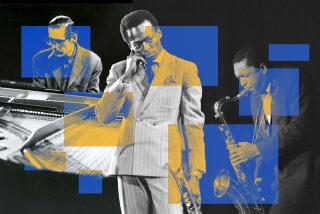Death, and All That Jazz : THE HOT JAZZ TRIO<i> by William Kotzwinkle illustrated by Joe Servello (Seymour Lawrence/Houghton Mifflin</i> :<i> $17.95; 153 pp.; 0-39550096-6) </i>
There are three stories in this slender volume. All have the word blues in their title. All are about death. The first takes place in a nostalgically conceived 1920s Paris of jazz and magic shows; the second in a cartoon of ancient Egypt, and the third in some America or other of hobos and traveling circuses. As is his habit, William Kotzwinkle has little interest in verisimilitude. Reality, we might say, is a crutch for those who can’t handle dreams.
Each tale in the trio reminds me of the interior of a crystal paperweight. Sharp edges have been banned, gravity is lenient (just watch the miniature blizzards, slower than falling feathers), and soft luminescence is the order of the day. Thus petted and protected from us, the inmates of the paperweight can live out their lives: the silk handkerchiefs sweetly reeking of ambisexuality, the wigs of great composers crawling with symphonies instead of lice, the boxes with their stolid lusts and greeds. . . .
But Kotzwinkle takes every opportunity to remind us that gravity must get its prey in the end. How could it be otherwise? After all, the snow crystals do settle eventually to the bottom of the liquid, just as the handkerchiefs will die of old age or might even be killed. “The penalty for taking the heavenly silkworms back to the dimension of earth is death,” says he. Magical commutations of execution occur when the author shakes his paperweight again and everything floats yet awhile longer, as in the last tale, when two high-wire circus performers elude Mr. Death several times by various stratagems, but in the end, “we tumbled on,” presumably to be shattered on the hard ground below. In every story, whether the paperweight is a giant bottle or the Egyptian realm of dead souls, dust comes to dust at last.
This is Kotzwinkle’s operating principle, and a very true one it is, too. Now, how well is it expressed? In the publicity matter that slathered my proof copy of this book, I learned that Kotzwinkle is a necromancer, a fantasist extraordinaire, and a magician--and this all on one page! (I wonder if he’s also a prestidigitator?). Wiping away this diarrhea (for which Kotzwinkle is not responsible), I picked up the three paperweights one by one and looked into them
The first of these, called “Django Reinhardt Played the Blues,” is by far the longest. Unfortunately, it is also the most disappointing. The sculpture within the dream-glass is prettily crafted enough, being “the world of shadows, and the thought of flowers, and convulsive moments.” Many of its denizens, its clock-cousins and semi-sentient umbrellas, deserve the life that Kotzwinkle has given them. But the story itself, the account of how LeBlanc the magician goes inside the paperweight to search for his beautiful Loli, is a series of blunders. Loli is LeBlanc’s assistant in a disappearing act. Disappear she has, reappear she does, and so do far too many supernumeraries, with far too little reason, until the game grows thin.
Kotzwinkle does not so much create character as an alloy of archetype and stereotype. So we have the master illusionist, the whore with the heart of gold, the sensual jazz musician, etcetera. It is not entirely a compliment to say that Kotzwinkle’s nonhuman characters are his most delightful, such as the sweet young thing who helps LeBlanc and his cronies escape from a city of hulking wardrobes:
“But then the box of chocolates under the American expatriate saxophonist’s arm spoke to the crowd, in her sweet voice, words only another box could understand. Her bonbons poured out. . . . Bonbons bounced off the boxes below, and there was a sound of latches creaking open in response to the little heart-shaped creature in her dainty silver wrapping.”
This is quite simply beautiful. Such passages are good as the best of Bradbury and Brautigan. I wish I could say the same about descriptions of LeBlanc and Loli.
For those who don’t mind a flabby plot, “Django Reinhardt” may offer considerable pleasure. There is one droll scene, for instance, in which Django is only halfway pulled into the other dimension. “ ‘How can I play the guitar? Mon dieu, Mon dieu . . . .’ He hopped around on one leg. ‘This is the most uncomfortable arrangement conceivable. . . .’ ”
The second story, “Blues on the Nile,” seemed to me more carefully written. I will not say very much about it because it is a mystery parable, with an ending that it would be unfair to reveal. Whereas death was an undercurrent inside the liquid of the paperweight in “Django Reinhardt,” it is everything in “Nile.” A Pharaoh dies, and is laid to rest, along with a few retainers conveniently suffocated to keep him company. All these characters, while neither novel nor individual, are nicely drawn. Kotzwinkle’s depiction of Pharaoh sipping beer through a straw as he views the progress of his tomb is perfect. (Here the stereotype-archetype business works, because the story has a point to make.) Soon the tomb becomes the paperweight, whose liquid is the Black Nile of the afterworld. Instead of a slow snowstorm we have a weightless Solar Barque skimming through the blackness--but gravity must have its due; the reckoning awaits. The images conveyed by the closing lines stay in the mind. (In my own short stories I fail all too often to be concise, so I admire the tightness of this piece.)
The final story, however, “Boxcar Blues,” is by far the finest in the collection. It begins with a brilliant screech: “Melrose rode his unicycle and I followed in my clown car. It crashed and I popped out the top in a spring-loaded seat, which is how I billed myself--Poppo the Clown. This was with the General Lopez Circus, that traveled all over the country, with winter quarters in the poorhouse.” And it goes on from there. If the Los Angeles Times would let me, I’d simply quote it all. There is hardly a false note in it. Melrose and Poppo go on the bum to flee the fishy-eyed Death who is determined to claim them, since their necks are technically broken. The paperweight is the life of boxcars and campfires. Again and again gravity is resisted, and Melrose and Poppo are saved by the generosity of their fellow losers. But we know what has to happen. There is a real sweetness to this story, as well as a sense of honest sadness.
In “Django Reinhardt,” there’s a character in a similar fix--a magician who was shot in the chest by his assistant and so is trapped in the paperweight for eternity. At the end, however, Kotzwinkle relents and lets him out--which is implausible and even phony. Here in “Boxcar Blues,” however, the author plays by his own rules: Gravity must win. Tramps can turn into butterflies. Tramps can turn themselves inside out. Tramps are eternally prepared to take off any minute. But tramps are no less doomed than anyone else.
So we see that “The Hot Jazz Trio” plays one theme, but the theme is big enough for any number of paperweights. As Kotzwinkle says: “The circus of General Lopez travels farther than we dreamed, Melrose.”
Joe Servello’s illustrations deserve mention. There are 30 of them, so they make up a substantial proportion of the book! Speaking as someone who has had to wrangle with publishers over the illustrations to my work (and has generally lost the fight), I feel very strongly that more fiction should be accompanied by pictures. So I am delighted to see Servello’s line drawings, for principle’s sake, and also because they are good. The naked jugglers, balancing balls on their heads like seals, the discombobulated boxman, Pharaoh in his sunglasses and General Lopez’s band are all there, and it is nice to see them. Servello is faithful to letter and spirit.
More to Read
The biggest entertainment stories
Get our big stories about Hollywood, film, television, music, arts, culture and more right in your inbox as soon as they publish.
You may occasionally receive promotional content from the Los Angeles Times.










